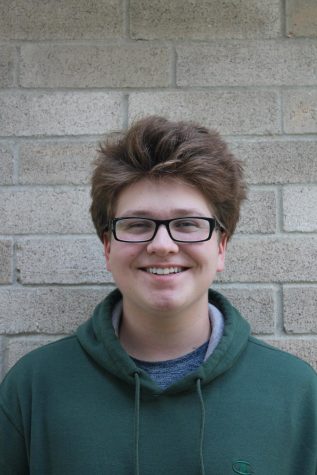Bot Blitz
Robotics Team Wraps Up Build Season
(From left to right): An early wooden prototype of the robot’s hopper mechanism, which takes balls from the floor to the shooter. Freshman William Lu machines a part on a drill press. Juniors Mateo Cannata and Sebastian Martinez discuss the hopper prototype.
February 28, 2020
There is a constant electronic hum as drills whir and lathes spin. Students are gathered around a table, assembling the long, lanky arms of their climbing mechanism. Outside their bay, on the playing field, another group of students feeds dodgeballs into a flywheel as they test another revision of their shooter prototype. As their first competition looms just weeks away, everyone is focused on the ultimate goal, completing and testing their robot.
The CRyptonite Robotics team is in their build season.
Build season begins in early January with the Kickoff event, when the new design challenge for the year is revealed. After that, teams have about two months to create before their first competition.
“The game we have this year is called Infinite Recharge,” Anuraag Routray, senior and team President said. “It’s played on a field about the size of a basketball court in two teams of three robots each. The objective is to score as many of these dodgeball-sized balls as you can in about two minutes into this goal eight feet off the ground. After that, you have thirty seconds to drive to the middle and try to hang from a bar five feet off the ground.”
During Kickoff, the team works out their goals for the game, such as what tasks they think a competitive robot will need to be able to do. Based on this strategy, they begin to brainstorm and design mechanism to complete these goals.
“The prototyping phase is probably my favorite part of build season,” senior Tejas George, Vice President of Build, said. “Obviously, once it’s all done and you see the final robot running, that’s such a satisfying feeling. But during the prototyping phase, everyone’s so excited for the new game. They’ve got all these ideas and you don’t have to make them look pretty or anything. You fail a lot. If your designs never fail, then you haven’t tested them properly.”
While the mechanical team is working on different mechanisms, the programming team is also testing, trying different coding techniques and preparing for when they get to work on the robot later in season.
“In the first few weeks, we are mainly on our own with no bots to work with, so we do a lot of experimentation” Natalie Wang, junior and Programming Director, said. “Our team has a reputation of having some really nice code that we consistently get awards for at competitions, and you can’t win awards with the same boring old code year after year. We try experimenting with new techniques not just in early build season, but also in the off-season and during the summer when we have more time.”
After the initial prototyping phase is done, the various subsystems decide on their best design that will be used in the final robot. They then integrate all these mechanisms together for the “protobot,” the first iteration of the team’s full robot.
“Once we finish protobot, we can hand it off to the programmers to start working on as well as keep tweaking and refining it,” George said. “Once we have the protobot done, we’re looking at taking all that we learned from the individual prototypes and using that knowledge of what we can try to improve on to make our final robot design, which we will actually use at competitions.”
The team is not yet fully done with build season, but they are close, with their first competition scheduled for the end of February. As they reach the end, members say they are pleased with some of the changes they have made in the team’s structure and approach to the build process since last year.
“I would say this year is a lot more hands on in the way we do things and approach problems,” Emma Smith, junior and Climb subsystem co-lead, said. “Last year we spent a lot of time on brainstorming and it wasn’t a super productive use of our time. Now we just have a lot of teams going at once. Everyone is just focused on helping to find the best design.”


